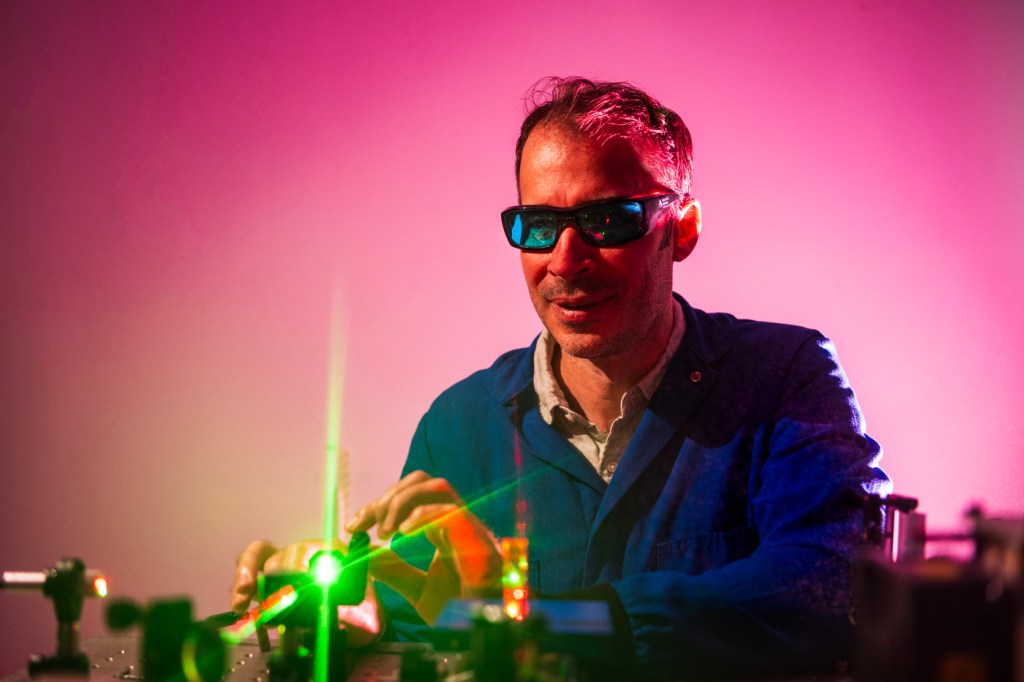New treatment for ovarian cancer will use lasers to target chemo-resistant cells

A biomedical physics lab at Northeastern has received a $2.7 million grant to develop a new treatment for ovarian cancer that will use lasers to spot and target chemo-resistant cancer cells and boost a patient’s immune system.
“We’re using light to power a therapy, if you will. We’re also using light to interrogate a tumor,” says Bryan Q. Spring, associate professor of biomedical physics at Northeastern University.
Spring’s lab, in collaboration with Heiko Enderling’s lab at MD Anderson Cancer Center and Moffitt Cancer Center, has been awarded a Physical Sciences Oncology Network grant of $2.7 million from the National Cancer Institute for a research project called “Fractionated photoimmunotherapy to harness low-dose immunostimulation in ovarian cancer.”
According to the American Cancer Society, ovarian cancer causes more deaths than any other cancer of the female reproductive system. It ranks fifth in cancer deaths among women, and is often diagnosed in late stages.
Women with advanced-stage ovarian cancer currently go through a grueling treatment regimen, Spring says, that includes surgical removal of visible cancerous tumors from the pelvis or abdomen (after the affected ovaries have been removed) and high-dose-intensity chemotherapy.
This standard approach frequently hits a wall due to drug-resistance and dose-limiting toxicity of chemotherapy. Surgeons sometimes have to leave affected areas in the abdomen for quality of life reasons, Spring says. An organ can lose its function if they cut too deep.
“The patients really suffer through that,” he says.
Chemo and surgery also can’t engage a person’s own immune system to fight cancer.
“Wouldn’t it be great if you could do a little bit of chemotherapy and then get the immune system engaged and use the body to fight the cancer and get the immune system to be able to do what it’s supposed to do,” Spring says.
The awarded grant, he says, allows the scientists to explore a light-activated treatment that’s been already tried in pilot clinical trials, with one agent doing phase III trials. The advantage of the light-based treatment, called photodynamic therapy or photoimmunotherapy, is that besides killing cancer cells it also engages and primes the immune system for follow up immunotherapy.
It may be possible to spare “good” immune cells, and even to stimulate their proliferation and activity to gobble up cancer cells, while deleting “bad” tumor cells that help cancer to evade the immune system, Spring says.
During the treatment, antibodies that target the cancer cells carry photoactive molecules of a nontoxic chemical. When they are targeted with light, the chemical molecules capture its energy, and toxic reactive species are created in a very localized area that does damage even to chemo-resistant cancer cells.
Another goal of Spring’s lab is to develop a miniature microscope that would go inside a body and interrogate a tumor using light. The device will use the power of very short pulses of light transmitted through an optical fiber for imaging.
Currently, such devices are big and not portable, Spring says, and can cost $50,000-$100,000. His lab is working on creating a lightweight, portable laser device that will cost about $10,000.
“We can stain cancer in the body and find out what proteins are available on the cell surface to target. Antibodies are then chosen to target proteins that the tumors express that are different from the background tissue,” Spring says. “We can take advantage of that to try to deliver our photosensitizers directly to the tumor and avoid off-target damage.”
The microscope would fit into a working channel of an endoscope that surgeons use. It will be possible to take high resolution images of tumor cells. By stitching these images together, Spring says, scientists then can use this information to do statistical calculations to determine what is going on.
The research is highly interdisciplinary, he says. Designing a laser requires mathematics and physics. Photophysics, math, quantum physics, biophysics and biochemistry are behind the concepts of how the therapy works and how tissues’ molecules absorb photons of light and then get converted into activated species that can do damage to cancer cells. Tumor immunology is also key for understanding biological responses to therapy.
Northeastern is the primary institution in this project that will conduct the experimental work for the treatment, Spring says. The Enderling lab will deploy mathematical oncology to project how a tumor is going to grow or respond to the treatment.
While Spring’s lab can provide unknown parameters derived from experiments to educate a mathematical model, the computational modeling scientists can create various models and simulate thousands of conditions that cannot be tested via experimentation.
“That helps narrow down what we actually want to test in a cell culture or more advanced preclinical models,” Spring says. “Mathematical oncology really helps us guide the experiments to learn the most. And then you have a mathematical model for the community to understand.”
Alena Kuzub is a Northeastern Global News reporter. Email her at a.kuzub@northeastern.edu. Follow her on Twitter @AlenaKuzub.






